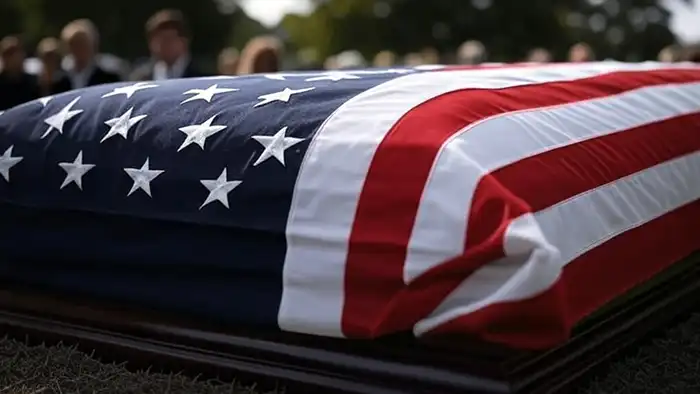United States Flag Etiquette
U.S. Flag Mourning Etiquette

The American Flag — draped over a casket
Dignitaries
The flag is to be flown at half staff in mourning for designated, principal government leaders and upon presidential or gubernatorial order.
Covering Caskets
When used to cover a casket, the flag should be placed with the union at the head and over the left shoulder. It should not be lowered into the grave.
Memorial Day
On Memorial Day the flag is displayed at half staff until noon and at full staff from noon to sunset.
- The flag is flown at half-staff (or half-mast on ships) to signify mourning, positioned at the midpoint of the staff or pole.
- To raise to half-staff, hoist to the peak briefly, then lower to half-staff. When lowering, raise to the peak before fully lowering.
- On Memorial Day, fly at half-staff until noon, then raise to the top for the remainder of the day.
The flag is flown at half-staff for prominent government officials or by order of the President or governors:
- 30 days: For the death of the President or a former President, across all federal buildings, grounds, and naval vessels.
- 10 days: For the Vice President, Chief Justice (or retired Chief Justice), or Speaker of the House.
- Until burial: For an Associate Justice, Cabinet member, former Vice President, or other high-ranking officials.
- Day of death and the following day: For a member of Congress.
- Governors may order half-staff for state officials or local mourning.
- The President may proclaim half-staff for national tragedies or other individuals.
- Crepe or Black Streamers: For fixed flagpoles, a black crepe streamer may be attached, though this is rare and not in the Flag Code.
- Stationary Flagpoles: Flags that cannot be lowered may remain at full height, but half-staff is preferred.
- Other Flags: When the U.S. flag is at half-staff, state, local, or organizational flags should also be at half-staff or not flown.
- The flag is not flown at half-staff for private citizens unless ordered by the President or a governor.
- On ships, the term is "half-mast," but the practice is identical.
- With other nations' flags, the U.S. flag is at half-staff only if others are similarly lowered.
- The flag should never touch the ground or be flown in disrepair during mourning.
- With other flags, the U.S. flag remains in its position of honor (to its own right) and is lowered first to half-staff.